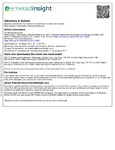Systemic-attachment formulation for families of children with autism
| dc.contributor.author | Hudson, M | |
| dc.contributor.author | Dallos, R | |
| dc.contributor.author | McKenzie, R | |
| dc.date.accessioned | 2017-11-23T17:04:19Z | |
| dc.date.issued | 2017-07-03 | |
| dc.identifier.issn | 2056-3868 | |
| dc.identifier.issn | 2056-3876 | |
| dc.identifier.uri | http://hdl.handle.net/10026.1/10263 | |
| dc.description | Publisher policy: author can archive post-print on institutional repository after 12 months embargo. Must link to publisher version with DOI. Publisher's version/PDF cannot be used. Published source must be acknowledged. | |
| dc.description.abstract |
<jats:sec> <jats:title content-type="abstract-subheading">Purpose</jats:title> <jats:p>Case formulation has gained increasing prominence as a guide to intervention across a range of clinical problems. It offers a contrasting orientation to diagnosis and its value is considered in the context of clinical work with autistic spectrum disorders (ASD). The purpose of this paper is to argue that case formulation integrating attachment, systemic and narrative perspectives offers a valuable way forward in assisting people with the diagnosis and their families.</jats:p> </jats:sec> <jats:sec> <jats:title content-type="abstract-subheading">Design/methodology/approach</jats:title> <jats:p>The literature on ASD and related conditions is reviewed to examine levels of co-morbidity, consider the role of parental mental health difficulties and explore the issues inherent with current approaches to diagnosis.</jats:p> </jats:sec> <jats:sec> <jats:title content-type="abstract-subheading">Findings</jats:title> <jats:p>ASD is found to have a high level of co-morbidity with other difficulties, such as anxiety and insecure attachment. Research findings, alongside the authors own clinical experience, are developed to suggest that formulation can allow the possibility of early intervention based on a holistic appraisal of the array of difficulties present prior to a diagnosis.</jats:p> </jats:sec> <jats:sec> <jats:title content-type="abstract-subheading">Originality/value</jats:title> <jats:p>It is argued that the use of this systemic-attachment formulation approach could offset the exacerbation in ASD and related conditions, and deterioration in families’ mental health, whilst they face long waiting times for a diagnosis.</jats:p> </jats:sec> | |
| dc.format.extent | 142-153 | |
| dc.language | en | |
| dc.language.iso | en | |
| dc.publisher | Emerald | |
| dc.subject | Autism | |
| dc.subject | Attachment | |
| dc.subject | Autism spectrum disorder | |
| dc.subject | Formulation | |
| dc.subject | Family systems | |
| dc.subject | Systemic therapy | |
| dc.title | Systemic-attachment formulation for families of children with autism | |
| dc.type | journal-article | |
| dc.type | Article | |
| plymouth.issue | 3 | |
| plymouth.volume | 3 | |
| plymouth.publication-status | Published | |
| plymouth.journal | Advances in Autism | |
| dc.identifier.doi | 10.1108/AIA-02-2017-0005 | |
| plymouth.organisational-group | /Plymouth | |
| plymouth.organisational-group | /Plymouth/Faculty of Arts, Humanities and Business | |
| plymouth.organisational-group | /Plymouth/Faculty of Arts, Humanities and Business/Plymouth Institute of Education | |
| plymouth.organisational-group | /Plymouth/Faculty of Health | |
| plymouth.organisational-group | /Plymouth/REF 2021 Researchers by UoA | |
| plymouth.organisational-group | /Plymouth/REF 2021 Researchers by UoA/UoA23 Education | |
| plymouth.organisational-group | /Plymouth/Users by role | |
| plymouth.organisational-group | /Plymouth/Users by role/Academics | |
| dcterms.dateAccepted | 2017-04-28 | |
| dc.rights.embargodate | 2018-7-3 | |
| dc.identifier.eissn | 2056-3876 | |
| dc.rights.embargoperiod | Not known | |
| rioxxterms.versionofrecord | 10.1108/AIA-02-2017-0005 | |
| rioxxterms.licenseref.uri | http://www.rioxx.net/licenses/all-rights-reserved | |
| rioxxterms.licenseref.startdate | 2017-07-03 | |
| rioxxterms.type | Journal Article/Review |


